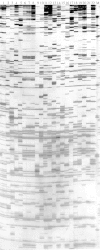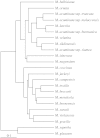Assessment of the validity of the sections in Musa (musaceae) using AFLP - PubMed (original) (raw)
Assessment of the validity of the sections in Musa (musaceae) using AFLP
Carol Wong et al. Ann Bot. 2002 Aug.
Abstract
Musa L. (Musaceae) is currently separated into five sections (Musa. Rhodochlamys, Callimusa, Australimusa and Ingentimusa) based on chromosome numbers and morphological characters. However, the validation of this classification system is questioned due to the common occurrence of hybridizations across sections and the system not accommodating anomalous species. This study employed amplified fragment length polymorphism (AFLP) in a phenetic examination of the relationships among four sections (material of sect. Ingentimusa was not available) to evaluate whether their genetic differences justify distinction into separate groups. Using eight primer combinations, a total of 276 bands was scored, of which 275 were polymorphic. Among the monomorphic bands, 11 unique markers were identified that revealed the distinct separation of the 11-chromosome species from the 10-chromosome species. AFLP results suggest that species of sect. Rhodochlamys should be combined into a single section with species of sect. Musa, and likewise for species of sect. Australimnusa to be merged with those of sect. Callimusa.
Figures
Fig. 1. AFLP profile generated by primer combination 1 (E‐AAC, M‐CAA). Lane 1, Ensete superbum; lane 2, E. glaucum; lane 3, Musa itinerans; lane 4, M. laterita; lane 5, M. sikkimensis; lanes 6–8, M. gracilis; lane 9, M. acuminata ssp. malaccensis; lane 10, M. balbisiana; lane 11, M. textilis; lane 12, M. violascens; lane 13, M. ornata; lane 14, M. coccinea; lane 15, M. nagensium; lane 16, M. campestris; lane 17, M. velutina; lane 18, M. jackeyi; lane 19, M. beccarii; lane 20, M. suratii; lane 21, M. monticola; lane 22, M. borneensis; lane M, pUC19/_Hpa_II molecular weight marker.
Fig. 2. Dendrogram showing genetic similarities between species of Musa and Ensete using UPGMA cluster analysis. Scale bar depicts GDEs.
Similar articles
- Musa genetic diversity revealed by SRAP and AFLP.
Youssef M, James AC, Rivera-Madrid R, Ortiz R, Escobedo-GraciaMedrano RM. Youssef M, et al. Mol Biotechnol. 2011 Mar;47(3):189-99. doi: 10.1007/s12033-010-9328-8. Mol Biotechnol. 2011. PMID: 20803102 - Nuclear genome size and genomic distribution of ribosomal DNA in Musa and Ensete (Musaceae): taxonomic implications.
Bartos J, Alkhimova O, Dolezelová M, De Langhe E, Dolezel J. Bartos J, et al. Cytogenet Genome Res. 2005;109(1-3):50-7. doi: 10.1159/000082381. Cytogenet Genome Res. 2005. PMID: 15753558 - Molecular phylogeny and systematics of the banana family (Musaceae) inferred from multiple nuclear and chloroplast DNA fragments, with a special reference to the genus Musa.
Li LF, Häkkinen M, Yuan YM, Hao G, Ge XJ. Li LF, et al. Mol Phylogenet Evol. 2010 Oct;57(1):1-10. doi: 10.1016/j.ympev.2010.06.021. Epub 2010 Jun 30. Mol Phylogenet Evol. 2010. PMID: 20601004 - Analysis of genetic diversity and sectional relationships in Musa using AFLP markers.
Ude G, Pillay M, Nwakanma D, Tenkouano A. Ude G, et al. Theor Appl Genet. 2002 Jun;104(8):1239-1245. doi: 10.1007/s00122-001-0802-3. Epub 2002 May 2. Theor Appl Genet. 2002. PMID: 12582576 - Banana (Musa spp) from peel to pulp: ethnopharmacology, source of bioactive compounds and its relevance for human health.
Pereira A, Maraschin M. Pereira A, et al. J Ethnopharmacol. 2015 Feb 3;160:149-63. doi: 10.1016/j.jep.2014.11.008. Epub 2014 Nov 13. J Ethnopharmacol. 2015. PMID: 25449450 Review.
Cited by
- Musa species in mainland Southeast Asia: From wild to domesticate.
Jenny C, Sachter-Smith G, Breton C, Rivallan R, Jacquemoud-Collet JP, Dubois C, Chabannes M, Lý NS, Haevermans T, Triệu TD, Insisiengmay O, Zhang T, Caruana ML, Sardos J, Perrier X. Jenny C, et al. PLoS One. 2024 Oct 2;19(10):e0307592. doi: 10.1371/journal.pone.0307592. eCollection 2024. PLoS One. 2024. PMID: 39356650 Free PMC article. - Evolution and Classification of Musaceae Based on Male Floral Morphology.
Inta W, Traiperm P, Ruchisansakun S, Janssens SB, Viboonjun U, Swangpol SC. Inta W, et al. Plants (Basel). 2023 Apr 10;12(8):1602. doi: 10.3390/plants12081602. Plants (Basel). 2023. PMID: 37111826 Free PMC article. - Comparative plastome analysis of Musaceae and new insights into phylogenetic relationships.
Fu N, Ji M, Rouard M, Yan HF, Ge XJ. Fu N, et al. BMC Genomics. 2022 Mar 21;23(1):223. doi: 10.1186/s12864-022-08454-3. BMC Genomics. 2022. PMID: 35313810 Free PMC article. - Dominant Allele Phylogeny and Constitutive Subgenome Haplotype Inference in Bananas Using Mitochondrial and Nuclear Markers.
Muiruri KS, Britt A, Amugune NO, Nguu E, Chan S, Tripathi L. Muiruri KS, et al. Genome Biol Evol. 2017 Oct 1;9(10):2510-2521. doi: 10.1093/gbe/evx167. Genome Biol Evol. 2017. PMID: 28992303 Free PMC article. - Evolutionary dynamics and biogeography of Musaceae reveal a correlation between the diversification of the banana family and the geological and climatic history of Southeast Asia.
Janssens SB, Vandelook F, De Langhe E, Verstraete B, Smets E, Vandenhouwe I, Swennen R. Janssens SB, et al. New Phytol. 2016 Jun;210(4):1453-65. doi: 10.1111/nph.13856. Epub 2016 Feb 1. New Phytol. 2016. PMID: 26832306 Free PMC article.
References
- AggarwalRK, Brar DS, Nandi S, Huang N, Khush GS.1999. Phylogenetic relationships among Oryza species revealed by AFLP markers. Theoretical and Applied Genetics 98: 1320–1328.
- ArgentGCG.1976. The wild bananas of Papua New Guinea. Notes from the Royal Botanic Garden Edinburgh 35: 77–114.
- ArgentGCG.2000. Two interesting wild Musa species (Musaceae) from Sabah, Malaysia. Gardens’ Bulletin Singapore 52: 203–210.
- BakerJG.1893. A synopsis of the genera and species of Museae. Annals of Botany 7: 189–229.
- BhatKV, Bhat SR, Chandel KPS.1992. Survey of isozyme polymorphism for clonal identification in Musa II. Peroxidase, superoxide dismutase, shikimate dehydrogenase and malate dehydrogenase. Journal of Horticultural Science 67: 737–743.

